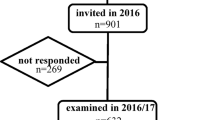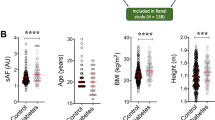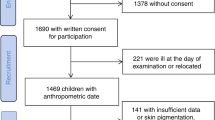Abstract
Stiffening of large arteries, clinically manifesting as increased aortic pulse wave velocity (PWV), is an inevitable outcome of aging. Among other mechanisms, impaired glucose metabolism plays an important role, leading to the deposition of advanced glycation end products (AGEs). This process is counterbalanced by the circulating soluble receptor for AGEs (sRAGE). We investigated the association between arterial stiffness on one side and multiple circulating biomarkers and the degree of skin deposition of AGEs on the other. In a cross-sectional design, 867 participants based on a general population sample (Czech post-MONICA studies) were examined. PWV was measured by SphygmoCor device (AtCor Medical Ltd.), while skin AGEs were measured using a dedicated autofluorescence method (AGE Reader mu®). To quantify the circulating status of AGEs, carboxymethyl lysine (CML) and sRAGE concentrations were assessed by ELISA, along with conventional glucose metabolism indicators. When analyzing the whole sample using multiple linear or logistic regression models and after adjustment for potential covariates, a significant association with PWV was found for fasting glycemia, HbA1c, sRAGE, skin AGEs, and the skin AGE-to-sRAGE ratio. Among these parameters, stepwise models identified the strongest association for the skin AGEs and AGE-to-sRAGE ratio, and this was also true when diabetic subjects were excluded. In contrast, neither CML nor its ratio relative to sRAGE showed any association with arterial stiffness. In conclusion, skin AGEs along with their ratio relative to sRAGE were closely associated with arterial stiffness and is a better indicator of the current status of deposited AGEs than other relevant factors.
This is a preview of subscription content, access via your institution
Access options
Subscribe to this journal
Receive 12 print issues and online access
$259.00 per year
only $21.58 per issue
Buy this article
- Purchase on SpringerLink
- Instant access to full article PDF
Prices may be subject to local taxes which are calculated during checkout

Similar content being viewed by others
References
O’Rourke MF, Mancia G. Arterial stiffness. J Hypertens. 1999;17:1–4.
Robert L. Aging of the vascular-wall and atherosclerosis. Exp Gerontol. 1999;34:491–501.
Folkow B, Svanborg A. Physiology of cardiovascular aging. Physiol Rev. 1993;73:725–64.
Cecelja M, Chowienczyk P. Dissociation of aortic pulse wave velocity with risk factors for cardiovascular disease other than hypertension: a systematic review. Hypertension. 2009;54:1328–36.
Collaboration TRVfAS. Determinants of pulse wave velocity in healthy people and in the presence of cardiovascular risk factors: ‘establishing normal and reference values’. Eur Heart J. 2010;31:2338–50.
Vlachopoulos C, Aznaouridis K, Stefanadis C. Prediction of cardiovascular events and all-cause mortality with arterial stiffness: a systematic review and meta-analysis. J Am Coll Cardiol. 2010;55:1318–27.
Herbert A, Cruickshank JK, Laurent S, Boutouyrie P. Establishing reference values for central blood pressure and its amplification in a general healthy population and according to cardiovascular risk factors. Eur Heart J. 2014;35:3122–33.
Goldin A, Beckman JA, Schmidt AM, Creager MA. Advanced glycation end products: sparking the development of diabetic vascular injury. Circulation. 2006;114:597–605.
Schleicher ED, Wagner E, Nerlich AG. Increased accumulation of the glycoxidation product N(epsilon)-(carboxymethyl)lysine in human tissues in diabetes and aging. J Clin Investig. 1997;99:457–68.
Singh R, Barden A, Mori T, Beilin L. Advanced glycation end-products: a review. Diabetologia. 2001;44:129–46.
Kalousova M, Zima T, Tesar V, Dusilova-Sulkova S, Skrha J. Advanced glycoxidation end products in chronic diseases-clinical chemistry and genetic background. Mutat Res. 2005;579:37–46.
Basta G. Receptor for advanced glycation endproducts and atherosclerosis: from basic mechanisms to clinical implications. Atherosclerosis. 2008;196:9–21.
Georgianos PI, Pikilidou MI, Liakopoulos V, Balaskas EV, Zebekakis PE. Arterial stiffness in end-stage renal disease-pathogenesis, clinical epidemiology, and therapeutic potentials. Hypertens Res. 2018;41:309–19.
Neeper M, Schmidt AM, Brett J, Yan SD, Wang F, Pan YCE, et al. Cloning and expression of a cell-surface receptor for advanced glycosylation end-products of proteins. J Biol Chem. 1992;267:14998–5004.
Vasan S, Zhang X, Kapurniotu A, Bernhagen J, Teichberg S, Basgen J, et al. An agent cleaving glucose-derived protein crosslinks in vitro and in vivo. Nature. 1996;382:275–8.
Koyama H, Yamamoto H, Nishizawa Y. RAGE and soluble RAGE: potential therapeutic targets for cardiovascular diseases. Mol Med. 2007;13:625–35.
Park L, Raman KG, Lee KJ, Lu Y, Ferran LJ Jr, Chow WS, et al. Suppression of accelerated diabetic atherosclerosis by the soluble receptor for advanced glycation endproducts. Nat Med. 1998;4:1025.
Gelžinský J, Mayer O Jr, Seidlerová J, Mateřánková M, Mareš Š, Kordíková V, et al. Soluble receptor for advanced glycation end-products independently influences individual age-dependent increase of arterial stiffness. Hypertens Res. 2020;43:111–20.
Mayer O, Seidlerova J, Filipovsky J, Vagovicova P, Wohlfahrt P, Cifkova R, et al. Soluble receptor for advanced glycation end products and increased aortic stiffness in the general population. Hypertens Res. 2016;39:266–71.
McNulty M, Mahmud A, Feely J. Advanced glycation end-products and arterial stiffness in hypertension. Am J Hypertens. 2007;20:242–7.
Semba RD, Najjar SS, Sun K, Lakatta EG, Ferrucci L. Serum carboxymethyl-lysine, an advanced glycation end product, is associated with increased aortic pulse wave velocity in adults. Am J Hypertens. 2009;22:74–9.
Dimitriadis K, Tsioufis C, Kasiakogias A, Miliou A, Poulakis M, Kintis K, et al. Soluble receptor for advanced glycation end-product levels are related to albuminuria and arterial stiffness in essential hypertension. Nutr Metab Cardiovasc Dis. 2013;23:382–8.
Meerwaldt R, Graaff R, Oomen PHN, Links TP, Jager JJ, Alderson NL, et al. Simple non-invasive assessment of advanced glycation endproduct accumulation. Diabetologia. 2004;47:1324–30.
Prasad K. Is there any evidence that AGE/sRAGE is a universal biomarker/risk marker for diseases? Mol Cell Biochem. 2019;451:139–44.
Cifkova R, Skodova Z, Bruthans J, Adamkova V, Jozifova M, Galovcova M, et al. Longitudinal trends in major cardiovascular risk factors in the Czech population between 1985 and 2007/8. Czech MONICA Czech post-Monica Atherosclerosis. 2010;211:676–81.
Wohlfahrt P, Cifkova R, Krajcoviechova A, Sulc P, Bruthans J, Linhart A, et al. Comparison of three office blood pressure measurement techniques and their effect on hypertension prevalence in the general population. J Hypertens. 2020;38:656–62.
Laurent S, Cockcroft J, Van Bortel L, Boutouyrie P, Giannattasio C, Hayoz D, et al. Expert consensus document on arterial stiffness: methodological issues and clinical applications. Eur Heart J. 2006;27:2588–605.
Levey AS, Stevens LA, Schmid CH, Zhang YL, Castro AF III, Feldman HI, et al. A new equation to estimate glomerular filtration rate. Ann Intern Med. 2009;150:604–12.
Piepoli MF, Hoes AW, Agewall S, Albus C, Brotons C, Catapano AL, et al. European Guidelines on cardiovascular disease prevention in clinical practice: the Sixth Joint Task Force of the European Society of Cardiology and Other Societies on Cardiovascular Disease Prevention in Clinical Practice (constituted by representatives of 10 societies and by invited experts) Developed with the special contribution of the European Association for Cardiovascular Prevention & Rehabilitation (EACPR). Atherosclerosis. 2016;2016:207–74.
Mayer O, Gelžinský J, Seidlerová J, Mateřánková M, Mareš Š, Svobodová V, et al. The role of advanced glycation end products in vascular aging: which parameter is the most suitable as a biomarker? J Hum Hypertens. 2020. https://doi.org/10.1038/s41371-020-0327-3. [Epub ahead of print].
Mac-Way F, Couture V, Utescu MS, Ignace S, De Serres SA, Loignon RC, et al. Advanced glycation end products, aortic stiffness, and wave reflection in peritoneal dialysis as compared to hemodialysis. Int Urol Nephrol. 2014;46:817–24.
Ueno H, Koyama H, Tanaka S, Fukumoto S, Shinohara K, Shoji T, et al. Skin autofluorescence, a marker for advanced glycation end product accumulation, is associated with arterial stiffness in patients with end-stage renal disease. Metabolism. 2008;57:1452–57.
Llauradó G, Ceperuelo-Mallafré V, Vilardell C, Simó R, Gil P, Cano A, et al. Advanced glycation end products are associated with arterial stiffness in type 1 diabetes. J Endocrinol. 2014;221:405–13.
Ageev FT, Vitsenia MV, Smirnova MD, Mihailov GV.The relationship between level of end-products of tissue glycation and pulse wave velocity in non-diabetic patients with cardiovascular disease. Kardiologiia. 2015;55:63–7.
Liu CY, Huang QF, Cheng YB, Guo QH, Chen Q, Li Y, et al. A Comparative Study on Skin and Plasma Advanced Glycation End Products and Their Associations with Arterial Stiffness. Pulse (Basel). 2017;4:208–18.
van Eupen MG, Schram MT, van Sloten TT, Scheijen J, Sep SJ, van der Kallen CJ, et al. Skin Autofluorescence and Pentosidine Are Associated With Aortic Stiffening: the Maastricht Study. Hypertension. 2016;68:956–63.
Stevens JW, Khunti K, Harvey R, Johnson M, Preston L, Woods HB, et al. Preventing the progression to type 2 diabetes mellitus in adults at high risk: a systematic review and network meta-analysis of lifestyle, pharmacological and surgical interventions. Diabetes Res Clin Pr. 2015;107:320–31.
Ahmed N. Advanced glycation endproducts–role in pathology of diabetic complications. Diabetes Res Clin Pr. 2005;67:3–21.
Conroy RM, Pyorala K, Fitzgerald AP, Sans S, Menotti A, De Backer G, et al. Estimation of ten-year risk of fatal cardiovascular disease in Europe: the SCORE project. Eur Heart J. 2003;24:987–1003.
Acknowledgements
We would like to acknowledge the hard work of all investigators and other coworkers (study nurses, laboratory technicians, medical students, etc.) who participated in the post-MONICA projects and, last but not least, all study subjects who voluntarily responded to the very time-consuming clinical examination program. The study realization was supported by the Health Development Agency of Czech Ministry of Health (project 15-27109), Charles University Research Fund (PROGRES, project Q39), and by Ministry of Health, Czech Republic - conceptual development of research organization. (FNPl, 00669806).
Author information
Authors and Affiliations
Corresponding author
Ethics declarations
Conflict of interest
The authors declare that they have no conflict of interest.
Additional information
Publisher’s note Springer Nature remains neutral with regard to jurisdictional claims in published maps and institutional affiliations.
Supplementary information
Rights and permissions
About this article
Cite this article
Gelžinský, J., Mayer, O., Seidlerová, J. et al. Serum biomarkers, skin autofluorescence and other methods. Which parameter better illustrates the relationship between advanced glycation end products and arterial stiffness in the general population?. Hypertens Res 44, 518–527 (2021). https://doi.org/10.1038/s41440-020-00601-1
Received:
Revised:
Accepted:
Published:
Issue Date:
DOI: https://doi.org/10.1038/s41440-020-00601-1
Keywords
This article is cited by
-
Advanced glycation end products measured by skin autofluorescence and subclinical cardiovascular disease: the Rotterdam Study
Cardiovascular Diabetology (2023)
-
Signaling pathways in vascular function and hypertension: molecular mechanisms and therapeutic interventions
Signal Transduction and Targeted Therapy (2023)
-
Time-varying parameters of glycemic control and glycation in relation to arterial stiffness in patients with type 1 diabetes
Cardiovascular Diabetology (2022)
-
Clinic and ambulatory blood pressure in relation to the interaction between plasma advanced glycation end products and sodium dietary intake and renal handling
Hypertension Research (2022)
-
Annual reports on hypertension research 2020
Hypertension Research (2022)



